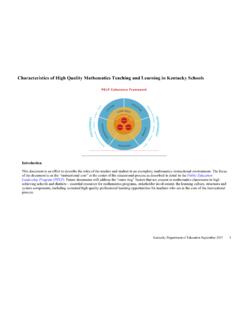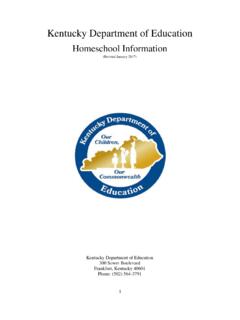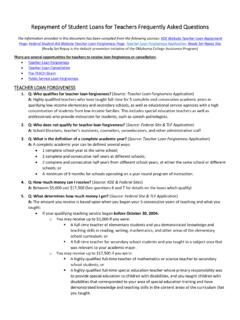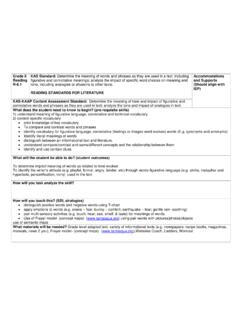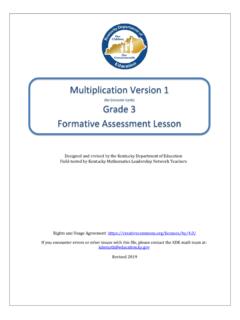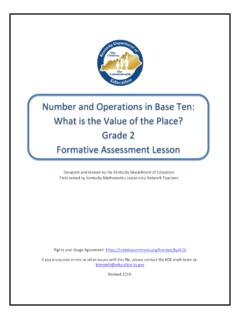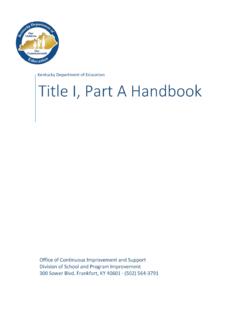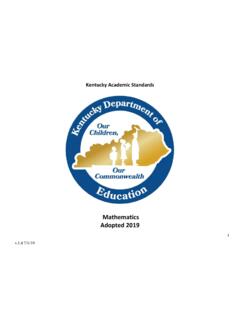Transcription of Lockdown Drills: Guide and Resource
1 Guide & ResourceLOCKDOWN DRILLSA pril 2021 MissionTo partner with districts, schools, families, students, business and industry, and communities to provide leadership and support to ensure success for each and every each and every student is empowered and equipped to pursue a successful Kentucky Department of Education is a service agency of the Commonwealth of Kentucky, and part of the Education and Workforce Development Cabinet. The department provides resources and guidance to Kentucky s public schools and districts as they implement the state s P-12 education requirements. The department also serves as the state liaison for federal education requirements and funding opportunities. AboutObjectives and Key Concepts 3 What is a Trauma-Informed Lockdown Drill? 3 What are the Kentucky Requirements for Lockdown Drills? 5 What Does the Research Tell Us about Lockdown Drills?
2 5 Tips for Trauma-Informed Lockdown Drills 6 Additional Resources 10 References 11 TABLE OF CONTENTSKENTUCKY DEPARTMENT OF EDUCATION2 OBJECTIVE AND KEY CONCEPTSWHAT IS A TRAUMA-INFORMED Lockdown DRILL?3 Objective: Students and staff learn best responses to maximize safety during a Lockdown in the event of an internal or external threat. Lockdown drills are conducted in a trauma-informed manner to minimize potential re-traumatizing of students or drills are a specific safety drill to prepare students and staff to achieve maximum safety in the event of an internal threat such as intruder or active shooter in the school building or on campus , or external threat, including community violence or disaster.
3 Lockdown drills are one component of a continuum of safety preparedness activities for students and staff that includes classroom lessons, tabletop exercises and experiential drills. Lockdown drills prepare students and staff to respond in the event of a Lockdown by teaching and practicing actions to stay safe and quiet in classrooms or other parts of the school. Students learn the basic imperatives to follow instructions, stay quiet and stay calm. Students naturally look to adults for guidance and instructions, and Lockdown drills help staff prepare to quickly assess the situation, make decisions, and Guide students to safety, while managing their own anxiety responses. All Lockdown drills should include three basic components: preparation, practice and Preparation: Classroom instruction about the steps to take during a Lockdown , expectations of how to behave during a drill and clear understanding of what to do if a student feels distressed.
4 Preparation may include a tabletop or storytelling Practice: Students and staff go through the action steps during a drill. This can be a walk-through with verbal prompts or a model response to a hypothetical situation. Effective practice drills do not require intense simulation using actors, sounds or fake weapons or ammunition, and there is no evidence that such simulations improve Processing: Students and staff should have the Safety preparedness is an essential part of the school emergency plan so students and staff are able to act to maximize safety in the event of a school emergency. Safety planning should include a continuum of activities for students and staff, and combine classroom learning and practice drills. All learning and drills should be tailored to meet the unique needs of schools and their students and staff, although they share core elements. All safety preparedness also should be designed to minimize the potential for causing or creating a traumatic experience for students and staff participating in the safety to discuss the drill, ask questions, express concerns and share emotional responses to the exercise .
5 This is best done at the classroom (rather than whole school) level, led by educators with whom students have a relationship. School staff should be trained to recognize signs of traumatic stress or other significant distress in students and colleagues that warrant referral for behavioral health support. There are two categories of Lockdown drills: Traditional Lockdown drills educate staff and students about what to do to remain safe in a classroom or other part of the school in the event of a Lockdown . This typically involves locking the door, moving students to a location out of sight through windows or upon entrance to the room, and coaching students to remain calm and quiet for the duration of the drill. These activities should be conducted in ways appropriate to the developmental level of the students involved, and using appropriate language and examples. Resources for elementary school drills have been compiled into the Elementary School Lockdown Workbook prepared by the Kentucky Center for School drills teach additional actions for maximizing safety, including leave the scene (run), hide, Lockdown and barricade in place or actively resist the intruder.
6 While several options-based programs exist for students and staff, the Kentucky Center for School Safety recommends that the option to resist/defend be offered only to staff who wish to participate, and never to students of any age. Options-based models can enhance student and staff awareness of emergency situations to enhance decision-making in the moment, but must always appropriately meet students developmental levels and minimize potential for increasing fear. The determination of whether to use a traditional or an options-based Lockdown drill should consider student and school factors. The National Association of School Psychologists (NASP) and the National Association of School Resource Officers (NASRO) recommend that traditional lockdowns should remain the foundation of an options-based approach. The Kentucky Center for School Safety has developed KCSS School Lockdown Planning Discussion Points to provide guidance to schools.
7 Lockdown drills should be tailored to meet the unique needs of the school community including consideration of: Student developmental level School and community culture and climate Physical layout and geography of the campus Accommodations for special needs of any students or staffLockdown drills may be effectively conducted with advance warning. Best practices indicate that there should be advance notice to students, families and staff of the drill as recommended in the KCSS School Lockdown Planning Discussion Points. School safety teams should also weigh the benefits of empowering students and staff versus the consequences of increasing anxiety, or unintentionally re-traumatizing individuals who have a history of adverse or traumatic experiences. Prior to conducting Lockdown drills, school safety teams should rigorously prepare for these exercises and consider all potential consequences.
8 Consider any accommodations that may be needed for students with IEPs or 504 plans. Students and staff who are known to have suffered recent losses or have a history of trauma exposure should be provided extra support before, during and after safety drills. Some students or staff who may be harmed by participation in the drill may need alternate learning methods and media ( books, one-on-one or small group discussion, tabletop exercises, or one-on-one or small group walk-through) to ensure they learn the required safety skills in accordance with legislative requirements. 4 Although schools have become increasingly concerned about the possibility of school violence, statistically schools remain among the safest places for youth to be, and school shootings are statistically rare events (Schildkraut, Formica and Malatras, 2018). There is limited research available on the effectiveness of drills in preparing students to respond to emergency situations, especially with regard to students at elementary and secondary levels, and those data are not always conclusive (Jonson, 2017; Zhang, Musu-Gillette and Ouderkerk, 2016).
9 At least one study found that students reported feeling more prepared for a Lockdown emergency in the short term following training and drills, without significant increases in anxiety or fear about their safety at school (Zhe and Nickerson, 2007). Recent data indicate that while students felt more familiar with Lockdown protocols after completing a series of educational lessons and two Lockdown drills, they also reported feeling less safe in school. Students who were black, biracial and multiracial were particularly noted to report feeling less safe at school, and female students reported feeling less safe than their male peers following the training and drill. Students in combined K-8 buildings reported feeling safer and more prepared than older students in middle and high school settings (Schildkraut, Nickerson and Ristoff, 2020). There also is some research indicating that for adults, a multi-option approach may be more effective than traditional Lockdown drills (Jonson, Moon and Hendry, 2020) but additional research is needed.
10 There also is concern that drills can create increased anxiety and fear among students and staff. Young students in particular may have difficulty distinguishing the drill from an actual emergency (Shalchi, 2019; Walker, 2019; , 2020). Numerous expert opinions (NASP/NASRO, 2017; National Child Traumatic Stress Network (NCTSN), 2019) recommend announcing drills in advance, adapting language and activities to address varying developmental levels, and attending to needs of students and staff with Individual Education Plans or 504 plans or other special circumstances. Recently, there has been a proliferation of negative reports of student response to WHAT DOES THE RESEARCH TELL US ABOUT Lockdown DRILLS?5 WHAT ARE THE KENTUCKY REQUIREMENTS FOR LOCK-DOWN DRILLS?KRS (5) requires two (2) Lockdown drills each school year: The principal shall conduct, at a minimum, emergency response drills to include.
